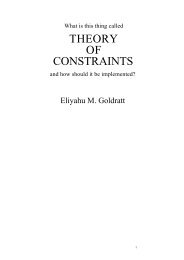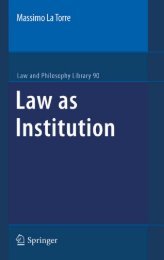Making of a German Constitution : a Slow Revolution
Making of a German Constitution : a Slow Revolution
Making of a German Constitution : a Slow Revolution
You also want an ePaper? Increase the reach of your titles
YUMPU automatically turns print PDFs into web optimized ePapers that Google loves.
A Century <strong>of</strong> Promise • 171<strong>of</strong> work, <strong>of</strong>ten keeping the books in their fathers’ businesses. 20 As a result <strong>of</strong> thisegalitarian distribution <strong>of</strong> power, wives represented their households in the publicspace as mistresses <strong>of</strong> the house and not only as their husbands’ representatives. 21These conditions were a far cry from Jacob Grimm’s imagined place <strong>of</strong> women asthe Schlüsselträgerinnen <strong>of</strong> their husbands.In his study on Neckarhausen, David Sabean has shown that, as farm womenincreasingly produced cash crops in the early nineteenth century and contributedgreater wealth to the family purse, they began to demand a say in the disposal <strong>of</strong>both the products they produced and their proceeds. Husbands and wives met on amore equal footing and, as Sabean demonstrates, these changing economic conditionswere reflected in local court decisions. ‘Courts’, accordingly, ‘shifted in theway they related to the family.’ 22 While, in the beginning, ‘they sought to effectcontrol by enhancing the authority <strong>of</strong> the Hausvater’, over time, ‘they came to actmore flexibly, allying with whichever spouse seemed to be the most effective commodityproducer’. 23The daily reality <strong>of</strong> nineteenth-century gender relations did not reflect liberal sociopoliticaldemands or their imagined Gemeinwesen. At the same time, it is importantto understand also that the family was a metaphor for the state in the <strong>German</strong>ists’political theory. In the aftermath <strong>of</strong> the Carlsbad Decrees <strong>of</strong> 1819, as I have mentioned,the discussion <strong>of</strong> public law and constitutions was virtually banned. It was inthis environment that political science found expression as legal history on <strong>German</strong>private law. This changing reality was evident in Eichhorn’s shifting focus from municipalconstitutions to private law. However, Eichhorn inverted the basis <strong>of</strong> participationand pointed toward the critical importance <strong>of</strong> private property ownership asthe basis <strong>of</strong> vollkommene Freiheit. While participation and everything connected withit underwent a process <strong>of</strong> masculinization, exclusion underwent a theoretical process<strong>of</strong> feminization. This was evident in Grimm’s analysis <strong>of</strong> symbols and language, forexample. It also served to underscore a point that Dieter Grimm makes, namely, thatthe codification <strong>of</strong> private law ‘at no time was isolated from the social reality andquestions <strong>of</strong> political organization’. 24Accordingly, descriptions <strong>of</strong> gender relations in the family were the metaphoricalter ego <strong>of</strong> public relationships <strong>of</strong> power and conceptions <strong>of</strong> exclusive legal personality.It was a narrative that did not target wealthy women alone, but also the dangers<strong>of</strong> working-class women, who were also acquiring property. Kathleen Canning hasshown how ‘narratives <strong>of</strong> danger about female factory labor were constituted across arange <strong>of</strong> statements, texts, signs, and practices: from academic lectures and scientificsurveys, state inquiries and parliamentary resolutions, to union brochures and[anti-]feminist tracts, employers’ sanctions, and even calls for strikes against thehiring <strong>of</strong> women workers’. 25 These narratives contributed to the passage <strong>of</strong> so-calledprotective legislation, namely, the Labor Code <strong>of</strong> 1878, which prohibited femalelabor in the mines at the same time that it required three weeks maternity leave;and the revised Code <strong>of</strong> 1891, which, amongst other policing measures, prescribed




